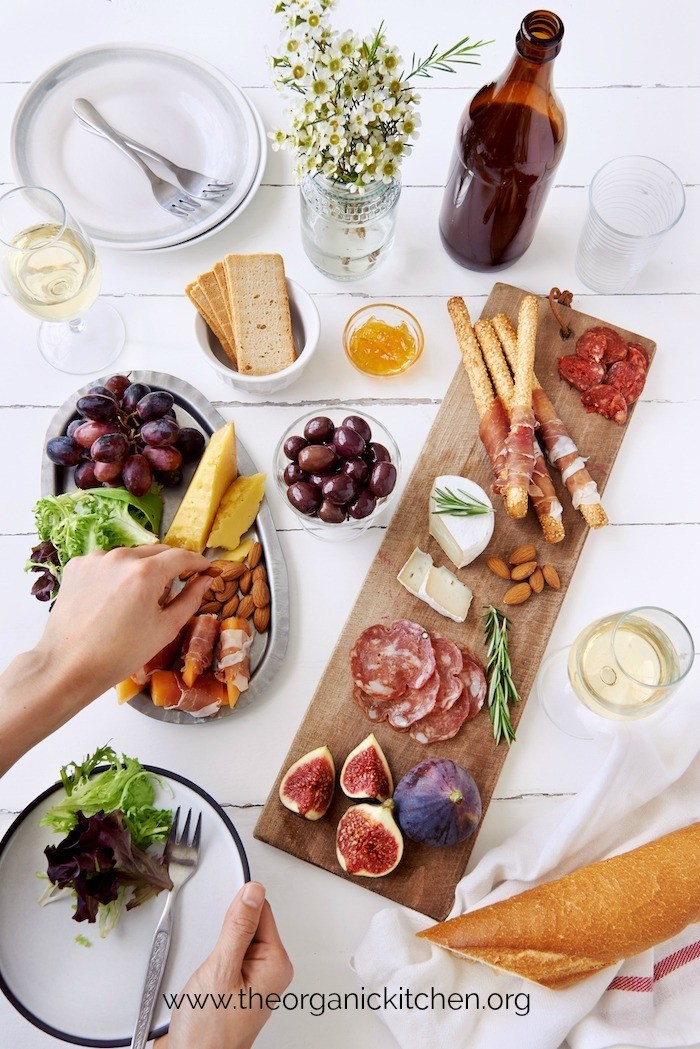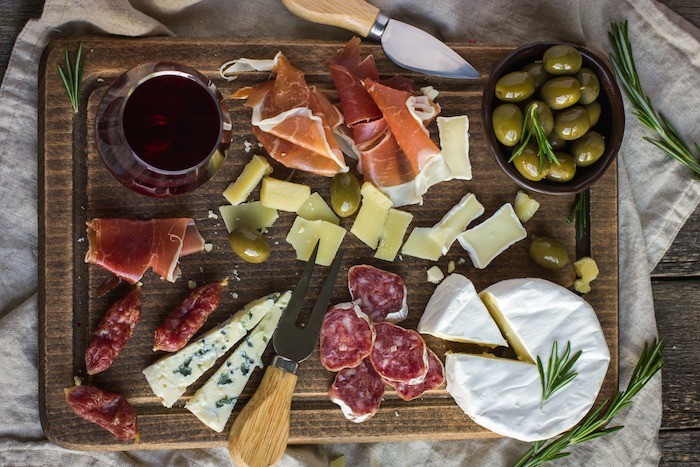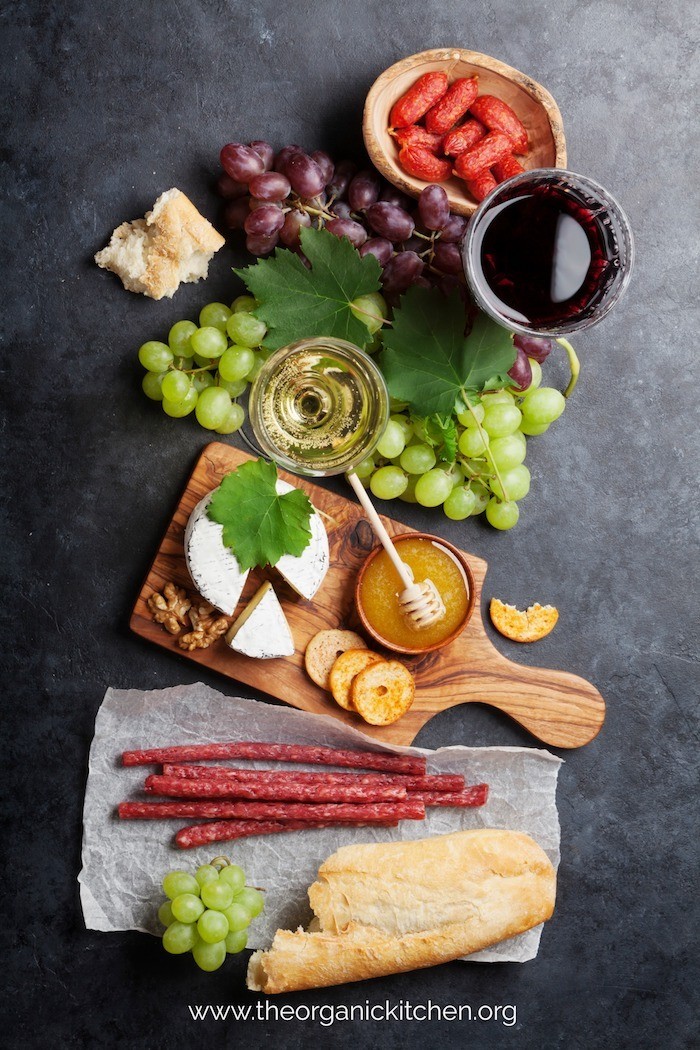Charcuterie, a culinary art form, is more than just a trend; it’s an experience. Eager to understand charcuterie, its history, preparation, and enjoyment? WHAT.EDU.VN provides comprehensive answers to your food-related queries, offering valuable insights into this delightful culinary trend. Explore cured meats, artisanal cheeses, and complementary accoutrements.
1. What is Charcuterie? A Culinary Definition
Charcuterie (pronounced “shahr-koo-tuh-ree”) is the art of preparing and assembling cured meats and meat products. It’s a French term that originally referred to shops specializing in pork products. Today, it encompasses a wide range of preserved meats, often served with cheese, crackers, fruits, and other accompaniments on a board or platter. A charcuterie board offers a delightful assortment of flavors and textures for a unique culinary experience.
1.1 The History of Charcuterie
Charcuterie dates back to ancient times when preserving meat was essential for survival. Before refrigeration, techniques like salting, smoking, and curing were used to extend the shelf life of meat. The French elevated this practice into an art form, with charcutiers developing specialized skills and recipes passed down through generations.
1.2 Key Elements of Charcuterie
A classic charcuterie board features a variety of cured meats, such as:
- Salami: A dry-cured sausage, often seasoned with garlic and spices.
- Prosciutto: A dry-cured ham, typically thinly sliced.
- Saucisson Sec: A French dry-cured sausage.
- Chorizo: A spicy, cured pork sausage.
- Pâté: A spreadable paste made from ground meat, often liver.
- Rillettes: Similar to pâté, but with a coarser texture.
- Coppa: Dry-cured pork shoulder or neck.
2. What Does Charcuterie Mean?
The word “charcuterie” is French, derived from “chair” (flesh) and “cuit” (cooked). Originally, it referred to pork butchers or those who prepared and sold cooked or cured pork products. Over time, the meaning has broadened to include a variety of cured and preserved meats, as well as the art of preparing and presenting them.
2.1 Charcuterie vs. Cheese Boards
While often combined, charcuterie and cheese boards are distinct. Charcuterie focuses on cured meats, while cheese boards showcase a variety of cheeses. However, a well-rounded board often includes both, along with complementary items like fruits, nuts, and crackers.
2.2 The Role of a Charcutier
A charcutier is a skilled professional who specializes in preparing charcuterie. They possess expertise in meat curing, sausage making, and other preservation techniques. Charcutiers often create their own unique recipes and flavor combinations, showcasing their artistry and culinary skills.
3. What to Put on a Charcuterie Board?
Creating a charcuterie board is an art form that allows for creativity and personalization. Here’s a breakdown of essential components and some ideas to inspire your own culinary masterpiece:
3.1 Cured Meats: The Heart of the Board
The cured meats are the star of any charcuterie board. Aim for a variety of flavors and textures to create an interesting and satisfying experience.
- Prosciutto: This dry-cured ham from Italy is known for its delicate, slightly salty flavor and melt-in-your-mouth texture.
- Salami: With countless varieties available, salami offers a wide range of flavors, from mild and savory to spicy and robust.
- Saucisson Sec: This classic French dry sausage is characterized by its firm texture and earthy flavor.
- Chorizo: A Spanish sausage, typically seasoned with paprika and other spices, providing a smoky and slightly spicy kick.
- Mortadella: A large Italian sausage made with finely ground pork and dotted with cubes of pork fat, offering a smooth and rich flavor.
- Pâté: This spreadable mixture of ground meat, fat, and seasonings adds a luxurious and creamy element to the board.
- Coppa: A dry-cured pork shoulder or neck, known for its rich, marbled texture and intense flavor.
3.2 Cheeses: A Perfect Complement
Cheese adds another layer of flavor and texture to the charcuterie board. Select a variety of cheeses, from soft and creamy to hard and aged, to complement the meats.
- Brie: A soft, creamy cow’s milk cheese with a bloomy rind.
- Cheddar: A firm, aged cheese with a sharp, nutty flavor.
- Gouda: A semi-hard cheese with a smooth, buttery flavor.
- Goat Cheese: A tangy, creamy cheese made from goat’s milk.
- Blue Cheese: A pungent, veined cheese with a distinctive flavor.
- Manchego: A firm, sheep’s milk cheese with a nutty, caramel-like flavor.
- Parmesan: A hard, granular cheese with a salty, savory flavor.
3.3 Breads and Crackers: The Vehicle for Flavor
Breads and crackers provide a neutral base for enjoying the meats and cheeses. Offer a variety of textures and flavors to suit different preferences.
- Baguette: A classic French bread with a crisp crust and soft interior.
- Crackers: Choose a variety of crackers, from plain and simple to flavored and artisanal.
- Breadsticks: Thin, crispy breadsticks offer a crunchy alternative to crackers.
- Toast Points: Small, toasted slices of bread provide a sturdy base for spreads and toppings.
- Gluten-Free Options: Offer gluten-free crackers or bread for guests with dietary restrictions.
3.4 Fruits and Vegetables: Adding Freshness and Color
Fruits and vegetables add a touch of sweetness, acidity, and visual appeal to the charcuterie board.
- Grapes: A classic addition to charcuterie boards, offering a sweet and juicy contrast to the savory meats and cheeses.
- Berries: Strawberries, blueberries, and raspberries add a burst of fresh flavor and vibrant color.
- Apples and Pears: Sliced apples and pears provide a crisp and refreshing element.
- Figs: Fresh or dried figs offer a sweet and slightly chewy texture.
- Olives: A variety of olives, from green to black, add a salty and briny flavor.
- Pickles: Pickled vegetables, such as cornichons or gherkins, provide a tangy and acidic contrast.
- Roasted Red Peppers: Sweet and slightly smoky, roasted red peppers add a vibrant color and flavor.
3.5 Spreads and Dips: Enhancing the Flavor
Spreads and dips add another layer of flavor and texture to the charcuterie board.
- Honey: A drizzle of honey adds a touch of sweetness and complements the savory flavors.
- Mustard: Dijon mustard or whole-grain mustard provides a sharp and tangy kick.
- Fig Jam: A sweet and fruity jam that pairs well with cheese.
- Olive Tapenade: A savory spread made from olives, capers, and anchovies.
- Hummus: A creamy dip made from chickpeas, tahini, and lemon juice.
3.6 Nuts and Seeds: Adding Crunch and Texture
Nuts and seeds add a satisfying crunch and nutty flavor to the charcuterie board.
- Almonds: A classic choice, offering a mild and versatile flavor.
- Walnuts: A rich and earthy flavor that pairs well with cheese.
- Pecans: A sweet and buttery flavor that complements the savory meats.
- Pistachios: A vibrant green nut with a slightly sweet and nutty flavor.
- Pumpkin Seeds: A crunchy and nutritious seed with a mild flavor.
3.7 Garnishes: The Finishing Touch
Garnishes add visual appeal and enhance the overall presentation of the charcuterie board.
- Fresh Herbs: Rosemary, thyme, and basil add a fragrant and colorful touch.
- Edible Flowers: Add a touch of elegance and whimsy with edible flowers.
- Lemon or Orange Slices: Add a bright and citrusy element.
4. How to Assemble a Charcuterie Board
Assembling a charcuterie board is a fun and creative process. Here are some tips to help you create a visually appealing and delicious spread:
4.1 Choose Your Board
Select a board that is large enough to accommodate all of your ingredients. Wood, slate, or marble boards are popular choices.
4.2 Start with the Anchors
Place the cheeses and larger items on the board first, spacing them out evenly. These will serve as the anchors for the rest of the ingredients.
4.3 Arrange the Meats
Fold, roll, or arrange the meats in visually appealing ways. Group similar meats together for a cohesive look.
4.4 Fill in the Gaps
Fill in the gaps with fruits, vegetables, nuts, and other smaller items.
4.5 Add Spreads and Dips
Place spreads and dips in small bowls or ramekins on the board.
4.6 Garnish and Serve
Garnish the board with fresh herbs, edible flowers, or other decorative elements. Serve immediately and enjoy.
5. What are the Benefits of Charcuterie?
Charcuterie offers several benefits, both culinary and social.
5.1 A Versatile Appetizer or Meal
Charcuterie can be served as an appetizer, a main course, or even a snack. It’s a versatile option that can be tailored to suit different occasions and preferences.
5.2 A Customizable Experience
Charcuterie is highly customizable, allowing you to create a board that reflects your personal tastes and dietary needs.
5.3 A Social and Engaging Activity
Charcuterie is a great way to bring people together and encourage conversation. It’s a shared experience that invites exploration and discovery.
5.4 A Celebration of Flavors and Textures
Charcuterie offers a delightful combination of flavors and textures, from the salty and savory meats to the creamy and tangy cheeses.
5.5 A Way to Explore Culinary Traditions
Charcuterie is rooted in culinary traditions that have been passed down through generations. It’s a way to connect with history and appreciate the art of food preservation.
6. Charcuterie Board Ideas for Different Occasions
Charcuterie boards can be customized for various occasions, from casual gatherings to elegant celebrations. Here are some ideas to inspire your creativity:
6.1 Holiday Charcuterie Board
Incorporate seasonal ingredients and colors to create a festive holiday-themed charcuterie board.
- Meats: Prosciutto-wrapped dates, cranberry-studded salami.
- Cheeses: Brie with fig jam, cranberry cheddar.
- Fruits: Pomegranate seeds, fresh cranberries, figs.
- Nuts: Candied pecans, spiced almonds.
- Garnishes: Rosemary sprigs, cinnamon sticks.
6.2 Vegetarian Charcuterie Board
Create a delicious and satisfying vegetarian charcuterie board with a variety of plant-based options.
- Cheeses: Variety of cheeses from different milk types (cow, goat, sheep).
- Vegetables: Roasted vegetables, marinated artichoke hearts, olives, pickles.
- Fruits: Grapes, berries, figs, dried apricots.
- Spreads: Hummus, baba ghanoush, pesto.
- Nuts: Almonds, walnuts, pistachios.
- Breads and Crackers: Assortment of artisanal bread and crackers.
6.3 Mediterranean Charcuterie Board
Transport your guests to the Mediterranean with a charcuterie board inspired by the flavors of the region.
- Meats: Chorizo, salami.
- Cheeses: Feta, halloumi, labneh.
- Vegetables: Roasted red peppers, olives, marinated artichokes, sun-dried tomatoes.
- Spreads: Hummus, tzatziki, baba ghanoush.
- Breads: Pita bread, crusty bread.
- Garnishes: Fresh mint, parsley.
6.4 Dessert Charcuterie Board
Satisfy your sweet tooth with a dessert charcuterie board featuring a variety of decadent treats.
- Chocolates: Assorted chocolates, truffles, chocolate-covered nuts.
- Fruits: Strawberries, raspberries, blueberries, grapes.
- Cookies: Biscotti, shortbread cookies, macarons.
- Cakes: Mini cheesecakes, brownies, cupcakes.
- Spreads: Nutella, caramel sauce, chocolate ganache.
- Garnishes: Whipped cream, sprinkles, chocolate shavings.
7. How to Pair Charcuterie with Wine
Wine and charcuterie are a match made in heaven. Here are some general guidelines for pairing wine with different types of charcuterie:
7.1 Light-Bodied Meats
Pair light-bodied meats like prosciutto and pâté with light-bodied white wines like Pinot Grigio or Sauvignon Blanc.
7.2 Rich and Fatty Meats
Pair rich and fatty meats like salami and saucisson sec with medium-bodied red wines like Pinot Noir or Beaujolais.
7.3 Spicy Meats
Pair spicy meats like chorizo with fruity red wines like Rioja or Côtes du Rhône.
7.4 Cheese
Pair cheese with wines that complement their flavor profiles. For example, pair brie with Chardonnay or goat cheese with Sauvignon Blanc.
8. Common Charcuterie Mistakes to Avoid
Even though charcuterie is relatively straightforward, here are some common mistakes to avoid:
8.1 Overcrowding the Board
Don’t overcrowd your board; it should look abundant but not messy.
8.2 Forgetting Dietary Restrictions
Always consider any dietary restrictions your guests might have, such as vegetarian, gluten-free, or dairy-free.
8.3 Neglecting Presentation
Presentation matters. Take the time to arrange items artfully and add garnishes for visual appeal.
8.4 Serving Cold Cheeses
Let cheeses come to room temperature for optimal flavor and texture.
8.5 Using Only One Type of Meat
Aim for variety in your meat selection to keep things interesting.
9. Frequently Asked Questions About Charcuterie
Still have questions about charcuterie? Here are some frequently asked questions to help you deepen your understanding:
| Question | Answer |
|---|---|
| What is the best way to store charcuterie? | Store cured meats in the refrigerator, wrapped tightly in plastic wrap or butcher paper. Cheese should also be stored in the refrigerator, wrapped in parchment paper or plastic wrap. |
| How long does charcuterie last? | Cured meats can last for several weeks in the refrigerator if stored properly. Cheese can last for a week or two, depending on the type. |
| Can I make charcuterie at home? | Yes, you can make some types of charcuterie at home, such as pâté and rillettes. However, curing meats requires specialized knowledge and equipment to ensure food safety. |
| What is the difference between charcuterie and deli meats? | Charcuterie typically refers to cured meats that have been preserved using traditional methods, while deli meats are often cooked or processed. |
| What are some good accompaniments for charcuterie? | Good accompaniments for charcuterie include cheese, crackers, fruits, vegetables, nuts, olives, pickles, spreads, and dips. |
| Is charcuterie healthy? | Charcuterie can be part of a healthy diet when consumed in moderation. Choose lean meats and cheeses, and balance your board with plenty of fruits, vegetables, and whole-grain crackers. |
| What is the best way to serve charcuterie? | Serve charcuterie at room temperature for optimal flavor. Arrange the ingredients on a board or platter, and provide small knives or spreaders for serving. |
| What is the origin of charcuterie? | Charcuterie originated in France as a way to preserve meat before refrigeration. |
| Can I use store-bought ingredients for charcuterie? | Absolutely. Using store-bought ingredients makes charcuterie boards accessible and easy to assemble. |
| What are some budget-friendly options for a charcuterie board? | Opt for less expensive meats like pepperoni or summer sausage. Use seasonal fruits and vegetables, and choose affordable cheeses like cheddar or mozzarella. Make your own crackers or breadsticks. |
| Are there any food safety concerns with charcuterie? | Yes, there are potential food safety concerns with charcuterie, particularly with improperly cured meats. Always purchase charcuterie from reputable sources, and follow proper storage and handling guidelines. |
| What are some regional variations of charcuterie? | Many regions have their own unique styles of charcuterie. For example, Italy is known for its prosciutto and salami, Spain for its chorizo and jamón, and France for its pâté and rillettes. |
| How can I make my charcuterie board visually appealing? | Use a variety of colors, textures, and shapes. Arrange the ingredients in an artful way, and add garnishes for a finishing touch. |
| What are some creative themes for charcuterie boards? | Some creative themes for charcuterie boards include a Mediterranean theme, a dessert theme, a holiday theme, or a vegetarian theme. |
| How do I transport a charcuterie board? | To transport a charcuterie board, wrap it tightly in plastic wrap or foil. If you’re transporting it a long distance, consider placing it in a cooler with ice packs. |
| What are some alternatives to a wooden board? | Slate boards, marble slabs, or even large platters can serve as stylish alternatives to wooden boards. |
| How can I incorporate a specific dietary theme (e.g., keto, vegan)? | Tailor your selections to fit the dietary theme. For keto, focus on high-fat meats and cheeses with low-carb accompaniments. For vegan, use plant-based cheeses, vegetables, and spreads. |
| Is charcuterie only for formal occasions? | Not at all. Charcuterie is versatile and can be enjoyed at casual gatherings, picnics, or even as a simple weeknight snack. |
| What are the essential tools for serving charcuterie? | Cheese knives, small tongs or forks, and spreaders are essential for serving charcuterie. |
| How can I involve guests in creating the charcuterie board? | Turn it into a collaborative experience. Provide a variety of ingredients and let guests assemble their own mini-boards or customize their plates. |





10. Where to Learn More About Charcuterie
To deepen your knowledge of charcuterie, consider the following resources:
- Culinary Schools: Many culinary schools offer courses in charcuterie and meat curing.
- Books: There are numerous books available on the art of charcuterie, providing detailed information on techniques, recipes, and history.
- Websites and Blogs: Many websites and blogs are dedicated to charcuterie, offering tips, recipes, and inspiration.
- Local Charcuteries: Visit local charcuteries and talk to the charcutiers to learn about their craft.
11. Elevate Your Gatherings with Charcuterie
Charcuterie is more than just a culinary trend; it’s a way to elevate your gatherings and create memorable experiences. By understanding the history, techniques, and ingredients involved, you can create your own stunning charcuterie boards that delight your guests and showcase your culinary creativity.
12. Beyond the Board: Creative Charcuterie Applications
Think beyond the traditional board. Charcuterie elements can be incorporated into various dishes to enhance flavor and presentation.
12.1 Charcuterie Skewers
Thread small pieces of cured meats, cheeses, olives, and vegetables onto skewers for a quick and easy appetizer.
12.2 Charcuterie Salad
Add diced charcuterie to a salad for a burst of flavor and protein.
12.3 Charcuterie Pizza
Top a pizza with sliced charcuterie, cheeses, and vegetables for a gourmet twist.
12.4 Charcuterie Sandwich
Create a delicious sandwich with layers of charcuterie, cheese, and your favorite toppings.
13. The Art of Gifting: Charcuterie Edition
A thoughtfully curated charcuterie basket or box makes a unique and impressive gift.
13.1 Selecting the Items
Choose high-quality cured meats, artisanal cheeses, and complementary accompaniments.
13.2 Presentation Matters
Arrange the items in an attractive basket or box, and add a personalized note.
13.3 Include Serving Utensils
Add cheese knives, spreaders, or small tongs for a complete gifting experience.
14. Charcuterie Across Cultures: A Global Perspective
While charcuterie is often associated with France, similar traditions exist in other cultures around the world.
14.1 Italy: Salumi and Antipasto
Italy is known for its salumi, a variety of cured meats, and its antipasto platters, which often include cured meats, cheeses, and vegetables.
14.2 Spain: Tapas and Jamón
Spain is famous for its tapas, small savory dishes, and its jamón, a dry-cured ham.
14.3 Germany: Wurst and Brotzeit
Germany is known for its wurst, a variety of sausages, and its Brotzeit platters, which often include sausages, cheeses, and bread.
15. Mastering the Charcuterie Craft: Tips from the Pros
To elevate your charcuterie skills, consider these tips from experienced charcutiers:
15.1 Source High-Quality Ingredients
The quality of your ingredients will directly impact the flavor and overall experience of your charcuterie board.
15.2 Experiment with Flavors
Don’t be afraid to experiment with different flavor combinations and try new ingredients.
15.3 Pay Attention to Detail
Pay attention to the details, from the arrangement of the ingredients to the selection of serving utensils.
15.4 Practice Makes Perfect
The more you practice, the better you will become at creating stunning and delicious charcuterie boards.
16. The Future of Charcuterie: Trends and Innovations
The world of charcuterie is constantly evolving, with new trends and innovations emerging all the time.
16.1 Plant-Based Charcuterie
Plant-based charcuterie boards are becoming increasingly popular, featuring a variety of vegan cheeses, meats, and other plant-based accompaniments.
16.2 Global Fusion
Charcuterie boards are incorporating flavors and ingredients from around the world, creating unique and exciting culinary experiences.
16.3 Sustainable Charcuterie
Sustainable charcuterie is gaining traction, with charcutiers focusing on sourcing ethically raised meats and using environmentally friendly practices.
17. Charcuterie and the Senses: An Immersive Experience
Engage all of the senses when creating and enjoying a charcuterie board.
17.1 Sight
Create a visually appealing board with a variety of colors, textures, and shapes.
17.2 Smell
Enjoy the aromas of the cured meats, cheeses, and other ingredients.
17.3 Taste
Savor the complex flavors of the charcuterie, paying attention to the different nuances.
17.4 Touch
Experience the different textures of the charcuterie, from the smooth and creamy cheeses to the firm and chewy meats.
17.5 Sound
Listen to the crunch of the crackers, the clinking of glasses, and the conversations of your guests.
18. Charcuterie for Solo Indulgence: A Treat for One
Charcuterie isn’t just for groups; it can be a delightful treat for one.
18.1 Scale Down the Portions
Create a smaller, more manageable board with just a few of your favorite items.
18.2 Pair with a Glass of Wine
Enjoy your charcuterie with a glass of wine for a truly indulgent experience.
18.3 Savor the Moment
Take the time to savor each bite and appreciate the flavors and textures.
19. Troubleshooting Common Charcuterie Challenges
Even experienced charcuterie enthusiasts encounter challenges from time to time.
19.1 Dry Meats
If your meats are dry, try marinating them in olive oil or balsamic vinegar before serving.
19.2 Bland Cheeses
If your cheeses are bland, try adding a sprinkle of sea salt or a drizzle of honey.
19.3 Overwhelming Flavors
If the flavors of your charcuterie board are overwhelming, try adding some neutral items like crackers or bread to balance things out.
20. Beyond the Basics: Advanced Charcuterie Techniques
For those looking to take their charcuterie skills to the next level, consider exploring advanced techniques.
20.1 Sausage Making
Learn how to make your own sausages from scratch, experimenting with different flavors and spices.
20.2 Meat Curing
Master the art of meat curing, using traditional methods to preserve and enhance the flavor of meats.
20.3 Pâté and Terrine Making
Explore the world of pâtés and terrines, creating elegant and flavorful dishes.
Charcuterie offers a rich tapestry of flavors, textures, and cultural traditions. Whether you’re a seasoned charcuterie enthusiast or a curious beginner, there’s always something new to discover. Embrace the art of charcuterie, experiment with different ingredients and techniques, and create unforgettable culinary experiences for yourself and your guests.
Do you have more questions about charcuterie or other culinary topics? Don’t hesitate to ask on WHAT.EDU.VN, where our experts are ready to provide you with accurate and insightful answers. Contact us at 888 Question City Plaza, Seattle, WA 98101, United States, or via WhatsApp at +1 (206) 555-7890. Visit our website at what.edu.vn for more information and to submit your questions today!
